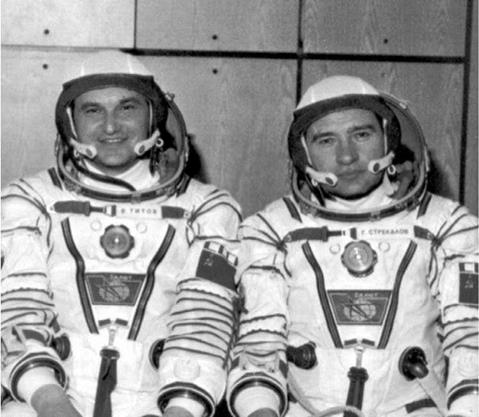SOYUZ PAD ABORT – A FAST RIDE AND A STIFF DRINK
Following Apollo 1, all manned space flights which attempted orbital flight succeeded in doing so up to 1975 and the aborted launch of Soyuz 18A (this mission exceeded 192km and since it is recorded as a “space mission”, it is detailed in the main log section). However, space flight is not without risk and two Soviet missions ended in tragedy and one Apollo lunar mission almost claimed the lives of the crew. In April 1967, the maiden manned flight of Soyuz ended in the tragic loss of its sole cosmonaut, Vladimir Komarov, after a difficult flight. In June 1971, the three Soyuz 11 cosmonauts died during the entry and landing phase after completing a successful 23-day mission to Salyut 1 – the first space station. In April 1970, an onboard explosion in the Service Module of Apollo 13 en route to the Moon caused the landing to be aborted as the mission became a fight to keep the crew alive and return them to Earth. The struggles and ingenuity of the crew, in conjunction with the sterling efforts of controllers and contractors and the support of their families, has become part of space folklore. These three missions can also be found in the main log. There was, however, another mission that was supposed to carry its crew into space in 1983, but it failed to even get off the ground – at least, not in the way the crew had expected to.
|
SOYUZ T10-1 |
|
|
Int. Designation |
None – pad abort seconds prior to launch |
|
Launched |
Planned 27 September 1983 |
|
Launch Site |
Pad 1, Baikonur Cosmodrome, Kazakhstan |
|
Landed |
Planned for late December 1983 |
|
Landing Site |
Planned for Kazakhstan |
|
Launch Vehicle |
R7 (Soyuz U); spacecraft serial number 16L |
|
Duration |
Planned for about 90 days (abort duration was 5 min 13 sec) |
|
Callsign |
Okean (Ocean) |
|
Objective |
Replace T9 crew on Salyut 7 to complete their original Soyuz T8 three-month resident programme with two EVAs to install additional solar array panels |
Flight Crew
TITOV, Vladimir Grigoryevich, 36, Soviet Air Force, commander, 2nd mission Previous mission. Soyuz T8 (1983)
STREKALOV, Gennady Mikhailovich, 43, civilian, flight engineer, 3rd mission Previous missions. Soyuz T3 (1980); Soyuz T8 (1983)
Flight Log
Fresh from their Soyuz T8 abortive docking attempt with Salyut the previous April, Vladimir Titov and Gennady Strekalov were paired for a possible long-duration mission later in the year, swapping with Soyuz T9’s Lyakhov and Aleksandrov. When Salyut 7 began to malfunction, the Soyuz T10 mission started to take on a repair status, with Titov and Strekalov trained to perform a spacewalk to place new solar panels on the outside of the station. At 01: 36 hours local time at Baikonur, the countdown of the Soyuz rocket reached T — 80 seconds and all seemed to be normal. A valve within the propellant valve failed to close and the base of the booster caught fire. Gradually a large fire rose up the side of the booster and a massive explosion was imminent.
The Soyuz T abort system was damaged by the fire, however, and it was another ten seconds before the ground control team recognised that there was a serious problem. A back-up abort procedure was put into action by two ground controllers
|
The Soyuz T10 abort cosmonauts Titov and Strekalov hoping to continue the programme they started on their T8 mission, five months before the pad abort |
in separate rooms. Titov and Strekalov must have known that there was a problem because the booster was by now pitching over 35° and engulfed in flames. It could not be seen by the controllers. With barely a second remaining before the cosmonauts disappeared into the conflagration, the launch escape system at last sprang into life.
The Descent and Orbital Modules of Soyuz T10 were electronically severed from the instrument section inside the payload shroud and the twelve solid propellant rockets at the top of the escape tower ignited, producing a thrust of 80,000 kg (176,400 lb). Titov and Strekalov were airborne, as the booster exploded. Pulling 18 G, the cosmonauts were powerless at first, then five seconds later, four aerodynamic panels were folded out to stabilise the strange projectile. Twenty-five smaller propellant rockets fired to maintain stabilisation.
Instantly, the Descent Module containing Titov and Strekalov was severed and literally fell out of the payload shroud at an altitude of about 1,050 m (3,444 ft). The back-up parachute was deployed, because its swifter opening time was well-suited for the low-altitude opening, and the re-entry heatshield deployed to expose the soft – landing rockets. Soyuz T10 hit the ground about 3.2 km (2 miles) away, as the pad was a sea of flames, burning for over 20 hours. Titov and Strekalov were administered a stiff glass of vodka but did not need hospital treatment. The experience did not put them off space flight as each flew again, probably believing the old adage that lightning never strikes twice. That lightning had struck once took time to filter through to the west, for details were not released for some time.
Milestones
1st use of crew launch escape system











